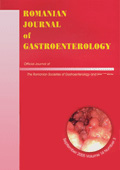The Effect of Chromoendoscopy on the Diagnostic Improvement of Gastric Ulcers by Endoscopists with Different Levels of Experience
Keywords:
Chromoendoscopy, gastric ulcer, diagnosisAbstract
Background. In recent years chromoendoscopy has become popular as a diagnostic enhancement tool in endoscopy. Using the macroscopic description of gastric ulcers, experienced endoscopists may be able to differentiate malignant and benign lesions. The aim of our study was to determine whether indigo carmine staining improves the ulcer differentiation by experienced and inexperienced endoscopists.
Methods. 50 patients were enrolled, 7 with malignant gastric ulcers and 43 with benign gastric ulcers. Gastroscopy was initially videotaped native, then on a second tape after staining with 0.2% indigo carmine. Later on biopsies were taken for histology. Subsequently the tapes were randomly evaluated by three experienced (>2000 gastroscopies; group A) and by three inexperienced (<100 gastroscopies; group B) investigators blinded from any personal data of the patients. The investigators had to classify the ulcers, using published criteria, native as well as stained. The results were compared within each group and with the histology.
Results. The endoscopic native diagnosis showed a sensitivity of 66.3%, a specificity of 86.3%, a positive predictive value of 48.1% and a negative predictive value of 94% for group A, respectively 66%, 62.5%, 22.7% and 92% for group B. After staining, the values of these parameters were reduced insignificantly to a sensitivity of 60.2%, a specificity of 78.5%, a positive predictive value of 36.1% and a negative predictive value of 92.8% for group A. Group B, on account of one investigator who demonstrated excellent skills, showed a significant better sensitivity (79.9%) and a slight improvement of the positive and negative predictive values to 25.7% respectively 94.8%, whereas the specificity very slightlydecreased to 61.3%. The diagnostic accuracy before and after staining was 83.6%, respectively 76.5%, in group A and 63.2%, respectively 63.9% in group B. The correlation with the histology, determined by Cohen‘s kappa coefficient (median value), decreased from 0.46 for the native to 0.30 for the chromoendoscopic diagnosis in group A and remained unchanged (0.17) in group B.
Conclusion. We concluded that chromoendoscopy does not improve the classification of gastric ulcers with respect to malignant or benign origin. The role of endoscopic experience could only be proved in the native macroscopic diagnosis of the investigators. After staining, with the exception of one investigator, experienced as well as inexperienced endoscopists lost their diagnostic accuracy.


